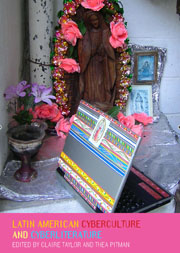Book contents
- Frontmatter
- Contents
- List of Illustrations
- Acknowledgements
- Foreword: Latin American Cyberliterature: From the Lettered City to the Creativity of its Citizens
- Notes on Contributors
- Introduction
- I Cyberculture and Cybercommunities
- II Cyberliterature: Avatars and Aficionados
- 9 Posthumanism in the Work of Jorge Luis Borges
- 10 Julio Cortázar's Rayuela and the Challenges of Cyberliterature
- 11 Contemporary Brazilian Fiction: Between Screens and Printed Pages
- 12 Creative Processes in Hypermedia Literature: Single Purpose, Multiple Authors
- 13 Hypertext in Context: Space and Time in the Hypertext and Hypermedia Fictions of Blas Valdez and Doménico Chiappe
- 14 Virtual Bodies in Cyberspace: Guzik Glantz's Weblog
- A Cyberliterary Afterword: Of Blogs and Other Matters
- Conclusion: Latin American Identity and Cyberspace
- Suggested Further Reading
- Index
12 - Creative Processes in Hypermedia Literature: Single Purpose, Multiple Authors
from II - Cyberliterature: Avatars and Aficionados
- Frontmatter
- Contents
- List of Illustrations
- Acknowledgements
- Foreword: Latin American Cyberliterature: From the Lettered City to the Creativity of its Citizens
- Notes on Contributors
- Introduction
- I Cyberculture and Cybercommunities
- II Cyberliterature: Avatars and Aficionados
- 9 Posthumanism in the Work of Jorge Luis Borges
- 10 Julio Cortázar's Rayuela and the Challenges of Cyberliterature
- 11 Contemporary Brazilian Fiction: Between Screens and Printed Pages
- 12 Creative Processes in Hypermedia Literature: Single Purpose, Multiple Authors
- 13 Hypertext in Context: Space and Time in the Hypertext and Hypermedia Fictions of Blas Valdez and Doménico Chiappe
- 14 Virtual Bodies in Cyberspace: Guzik Glantz's Weblog
- A Cyberliterary Afterword: Of Blogs and Other Matters
- Conclusion: Latin American Identity and Cyberspace
- Suggested Further Reading
- Index
Summary
Hypermedia Narratives
With the arrival of digital formats changes have occurred in the process of literary creation. In the traditional book, whatever the narrative voice or voices used in the text, the point of view corresponded solely to the author who worked alone, concerned only with his or her text. This is no longer the case. A hypermedia work will not usually have a single author, given the complexity of its conception. The creation of a multimedia narrative requires the involvement of a number of disciplines and therefore the intervention of numerous authors. The contrasting points of view of the artists involved, who interpret the story and transmit their perceptions, all converge in the work to be exhibited and this poses a challenge for these multiple authors. Writers of multimedia works – part of the artistic vanguard which I term ‘hypermedism’ – must explore innovative creative formats and, at the same time, achieve high quality content. Hypermedia works must display more than formal innovation, giving a literary depth to the works offered to readers.
In an authentic multimedia project the authors share the credit, as each one contributes a narrative plane from the artistic elements which, in the work's totality, are in balance and have equal importance. Alongside writers, plastic artists, musicians, and photographers there is the programmer who interprets the ways in which different arts are related to each other within the hypermedia narrative.
- Type
- Chapter
- Information
- Latin American Cyberculture and Cyberliterature , pp. 216 - 226Publisher: Liverpool University PressPrint publication year: 2007



